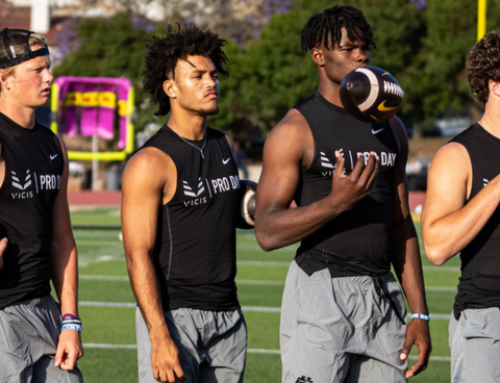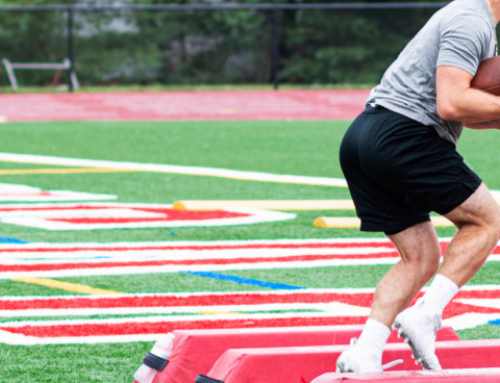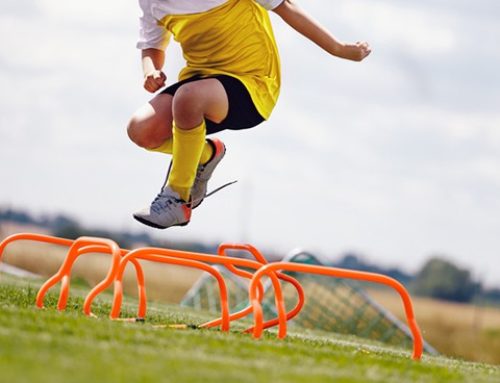How a Unique Speed Training Program Flipped the Fortunes of Indiana Football
It’s one of those classic coach-isms—“You can’t teach speed.”
Dr. Matt Rhea doesn’t buy it.
“The old adage you can’t teach speed or you can’t develop speed in guys at this level is just highly inaccurate,” says Rhea, the High Performance Coordinator for Indiana Football.
His Hoosiers are living proof. After decades spent as a doormat of the Big Ten, Indiana is turning heads with an assembly of exciting athletic talent. The team recently earned their first Top 25 ranking since 1994.
Player development has been a vital piece of the turnaround, as the Hoosiers have gone from having mediocre speed to boasting one of the fastest rosters in college football.
Rhea, along with IU Director of Football Performance Dave Ballou, arrived in Bloomington in January of 2018. Over the course of the next year, Indiana players saw their top running speed increase by an average of over 3 miles per hour.
The gains have continued into 2019, as Rhea reports Indiana’s “team speed”—a single figure based off each starter’s average in-game speed—is more than a mile per hour faster this season than it was last year.
“Team speed is what wins football games,” says Rhea. “Those kind of improvements are a combination of the intense work ethic of our players and the fact Dave Ballou and I are willing to invest a ton of time into individualizing this as best we can for our players.”
When it comes to speed, special results require a special approach.
“I hear people talk about, ‘All training is the same, people are basically all doing the same stuff, they might just package it different or sell it different.’ That drives me crazy, because I think our players have seen very quickly that (our program) absolutely doesn’t look like most other places they’ve seen or ways they’ve been told they should train,” says Rhea.
Speed factory was open for business today! @IndianaFootball pic.twitter.com/q0pzmmq13W
— Matt Rhea, PhD (@MattRheaPhD) July 10, 2019
A Professor of Kinesiology, Rhea uses an avalanche of data points to inform each player’s prescribed training methods.
Prior to Indiana, he was the head of sport science at IMG Academy, which is where he first collaborated with Ballou. The massive amount of intel he’s been able to gather on elite athletes in recent years has helped him form several pillar beliefs on speed.
“I’ve been studying speed for the last 20 years, but in the last five years, I’ve had just an incredible amount of data on strength, power, coordination and speed. And once I was able to accumulate a very large amount of data, you can really run these multiple regression analyses that I think tell us a lot more,” Rhea says.
For one, he’s found an athlete’s max strength has less of an impact on speed than you might think.
Many folks believe the best way to get faster is to get stronger—that if you can lift more weight, you’ll be able to put more force into the ground and propel yourself from A to B in less time. And since many regard the Barbell Back Squat as the “king” of lower-body exercises, pushing up your max there must be a surefire way to get faster.
Rhea’s found it isn’t quite that simple.
“The number I’m actually working off of now is 1.7 times your body weight. Once an athlete can squat 1.7 times their body weight, increases in squat strength beyond that are not contributing to speed,” says Rhea.
For a 200-pound athlete, 1.7 times their body weight would be 340 pounds.
While increasing their max beyond that could certainly have a positive impact on other factors of athletic performance, it doesn’t appear to independently contribute to further increases in speed. And even for athletes who cannot squat 1.7 times their body weight, their lack of strength is not the biggest deadweight on their speed.
Rhea’s research has also found a pure sprinting program with little-to-no resistance training isn’t the best way to get faster, either. Rather, it’s a combination of resistance training, sprint work, plyometrics and other modalities he’s found to be most effective. But the true secret ingredient in that formula is individualization.
“If we approached our entire team with the same methods for increasing speed, if you just took a conventional approach of (building) strength plus sprinting, I think it’d probably help maybe a third of our roster. The other two-thirds wouldn’t be getting what they actually need,” says Rhea.
While the strength and size of different muscle tissue plays a role in speed, it’s really an athlete’s neurological components that have the biggest impact on how fast they can run.
Expressing speed is about getting many different muscles to contract and relax at exactly the right times and in the exact right proportions. It sounds simple enough, but almost every athlete exhibits some sort of significant flaw in their ability to do so.
Regression analyses run by Rhea on four years of data from high school and college football players found that differences in muscle coordination patterns accounted for “nearly 55 percent of the variance in speed at all levels of strength, power and speed.”

After performing EMG tests on hundreds of athletes, Rhea’s identified five distinct muscle coordination flaws that commonly make people slower. For example, an imbalance in contribution between the hamstrings and quads during the act of sprinting.
Ideally, the ratio between how much each muscle group is being asked to contribute to the process is about 50/50.
“Really fast athletes actually have a pretty good ratio during running of how much the quads are working and how much the hamstrings are working,” says Rhea. “It’s not about the strength of the hamstrings or the strength of the quads, it’s the coordination of how much each is being asked to contribute…One flaw is that ratio might be way off.”
Different muscle coordination flaws require different fixes, and Rhea’s continually refining a toolbox of specialized resistance, plyometric and running exercises tailored to address each.
For example, an athlete who tends to be too quad-dominant during sprinting will likely benefit from more assisted or “overspeed” sprinting, which generally helps the hamstrings contribute more to the action. A heavy dose of resisted sprinting, on the other hand, would likely exacerbate the issue.
“That propensity to be dominant on one muscle group is very common across athletes,” Rhea says. “And that dominance isn’t always optimal for sports performance.”
In the weight room, a player’s resistance training program isn’t based on his position, but his specific neurological needs.
Since football is a power sport, Rhea and Ballou prioritize power output over the amount of weight on the bar. Only about 30 percent of the team’s training volume calls for a load equal to or exceeding 80% of a player’s one-rep max. Despite power being the main priority, the players’ max strength has ballooned, as well. In July 2018, the Hoosiers had nine players capable of back squatting 500-plus pounds. This July, the number swelled to 32.
Many exercises involve a unilateral component, as Rhea’s research has found muscle recruitment patterns during a single-leg or split-stance movement are often far different from a bilateral equivalent—and usually more akin to what’s required during sprinting.
The Hands-Supported Safety Bar Split Squat is one example. Some might see the exercise as being “too slow” to develop speed, but Rhea says exercise speed is just one element of specificity of training.
“We really use a lot of single-leg or split-stance movements. The reason behind that traces back to EMG research I’ve done—there’s very different recruitment patterns. You might see the same amount of stress on specific muscle groups, but the pattern of activation and relaxation is very different when you go into a split stance vs. a traditional bilateral Squat,” says Rhea.
@SuperstarWhop locked and loaded for a big comeback year. @IndianaFootball pic.twitter.com/4l2b2tGJZ7
— Matt Rhea, PhD (@MattRheaPhD) July 17, 2019
“My approach to speed development is targeting the wiring, not necessarily the bigger components like muscle tissue or even contractile components—it’s the wiring. So when we select exercises for speed development, it’s based on what we really think (they need) in that wiring component…(Making an exercise unilateral) adds a complexity to the lift that is more neurological than it is muscular.”
The Hoosiers also utilize movements where the translation to sprinting is more obvious to the naked eye, such as this doozy of a plyometric variation on a Glute-Ham Bridge.
“The contract-relax patterns in an exercise like that are very challenging. That’s literally what we’re trying to develop, is the ability of the muscles to contract and relax in a pattern that transfers to sprinting,” says Rhea.
3D cameras on every weight rack track essential metrics like bar speed and power. The 1080 Sprint, a portable device that can apply resistance or assistance to an athlete’s sprint while spitting out loads of valuable data on their gait pattern, is another favored tool.
Rhea regularly utilizes EMG testing to assess how well a player’s program is addressing muscle coordination deficiencies. As their muscle coordination improves, their speed times inevitably drop. Many Hoosiers have shaved three-tenths of a second off their 40-Yard Dash over the course of a single off-season. With results like that, the program sells itself.
“When I do EMG testing, our players absolutely love looking at their coordination patterns and comparing it to past results. It’s my way of kind of infiltrating their minds and turning them all into some sport scientists,” says Rhea. “The more they understand, the more intrigued they get. The more intrigued they get, the more they focus on what we’re doing. The more focus, the more confidence and buy-in I think we see.”
Photo Credit: Jeremy Hogan/Getty Images
READ MORE:
RECOMMENDED FOR YOU
How a Unique Speed Training Program Flipped the Fortunes of Indiana Football
It’s one of those classic coach-isms—“You can’t teach speed.”
Dr. Matt Rhea doesn’t buy it.
“The old adage you can’t teach speed or you can’t develop speed in guys at this level is just highly inaccurate,” says Rhea, the High Performance Coordinator for Indiana Football.
His Hoosiers are living proof. After decades spent as a doormat of the Big Ten, Indiana is turning heads with an assembly of exciting athletic talent. The team recently earned their first Top 25 ranking since 1994.
Player development has been a vital piece of the turnaround, as the Hoosiers have gone from having mediocre speed to boasting one of the fastest rosters in college football.
Rhea, along with IU Director of Football Performance Dave Ballou, arrived in Bloomington in January of 2018. Over the course of the next year, Indiana players saw their top running speed increase by an average of over 3 miles per hour.
The gains have continued into 2019, as Rhea reports Indiana’s “team speed”—a single figure based off each starter’s average in-game speed—is more than a mile per hour faster this season than it was last year.
“Team speed is what wins football games,” says Rhea. “Those kind of improvements are a combination of the intense work ethic of our players and the fact Dave Ballou and I are willing to invest a ton of time into individualizing this as best we can for our players.”
When it comes to speed, special results require a special approach.
“I hear people talk about, ‘All training is the same, people are basically all doing the same stuff, they might just package it different or sell it different.’ That drives me crazy, because I think our players have seen very quickly that (our program) absolutely doesn’t look like most other places they’ve seen or ways they’ve been told they should train,” says Rhea.
Speed factory was open for business today! @IndianaFootball pic.twitter.com/q0pzmmq13W
— Matt Rhea, PhD (@MattRheaPhD) July 10, 2019
A Professor of Kinesiology, Rhea uses an avalanche of data points to inform each player’s prescribed training methods.
Prior to Indiana, he was the head of sport science at IMG Academy, which is where he first collaborated with Ballou. The massive amount of intel he’s been able to gather on elite athletes in recent years has helped him form several pillar beliefs on speed.
“I’ve been studying speed for the last 20 years, but in the last five years, I’ve had just an incredible amount of data on strength, power, coordination and speed. And once I was able to accumulate a very large amount of data, you can really run these multiple regression analyses that I think tell us a lot more,” Rhea says.
For one, he’s found an athlete’s max strength has less of an impact on speed than you might think.
Many folks believe the best way to get faster is to get stronger—that if you can lift more weight, you’ll be able to put more force into the ground and propel yourself from A to B in less time. And since many regard the Barbell Back Squat as the “king” of lower-body exercises, pushing up your max there must be a surefire way to get faster.
Rhea’s found it isn’t quite that simple.
“The number I’m actually working off of now is 1.7 times your body weight. Once an athlete can squat 1.7 times their body weight, increases in squat strength beyond that are not contributing to speed,” says Rhea.
For a 200-pound athlete, 1.7 times their body weight would be 340 pounds.
While increasing their max beyond that could certainly have a positive impact on other factors of athletic performance, it doesn’t appear to independently contribute to further increases in speed. And even for athletes who cannot squat 1.7 times their body weight, their lack of strength is not the biggest deadweight on their speed.
Rhea’s research has also found a pure sprinting program with little-to-no resistance training isn’t the best way to get faster, either. Rather, it’s a combination of resistance training, sprint work, plyometrics and other modalities he’s found to be most effective. But the true secret ingredient in that formula is individualization.
“If we approached our entire team with the same methods for increasing speed, if you just took a conventional approach of (building) strength plus sprinting, I think it’d probably help maybe a third of our roster. The other two-thirds wouldn’t be getting what they actually need,” says Rhea.
While the strength and size of different muscle tissue plays a role in speed, it’s really an athlete’s neurological components that have the biggest impact on how fast they can run.
Expressing speed is about getting many different muscles to contract and relax at exactly the right times and in the exact right proportions. It sounds simple enough, but almost every athlete exhibits some sort of significant flaw in their ability to do so.
Regression analyses run by Rhea on four years of data from high school and college football players found that differences in muscle coordination patterns accounted for “nearly 55 percent of the variance in speed at all levels of strength, power and speed.”

After performing EMG tests on hundreds of athletes, Rhea’s identified five distinct muscle coordination flaws that commonly make people slower. For example, an imbalance in contribution between the hamstrings and quads during the act of sprinting.
Ideally, the ratio between how much each muscle group is being asked to contribute to the process is about 50/50.
“Really fast athletes actually have a pretty good ratio during running of how much the quads are working and how much the hamstrings are working,” says Rhea. “It’s not about the strength of the hamstrings or the strength of the quads, it’s the coordination of how much each is being asked to contribute…One flaw is that ratio might be way off.”
Different muscle coordination flaws require different fixes, and Rhea’s continually refining a toolbox of specialized resistance, plyometric and running exercises tailored to address each.
For example, an athlete who tends to be too quad-dominant during sprinting will likely benefit from more assisted or “overspeed” sprinting, which generally helps the hamstrings contribute more to the action. A heavy dose of resisted sprinting, on the other hand, would likely exacerbate the issue.
“That propensity to be dominant on one muscle group is very common across athletes,” Rhea says. “And that dominance isn’t always optimal for sports performance.”
In the weight room, a player’s resistance training program isn’t based on his position, but his specific neurological needs.
Since football is a power sport, Rhea and Ballou prioritize power output over the amount of weight on the bar. Only about 30 percent of the team’s training volume calls for a load equal to or exceeding 80% of a player’s one-rep max. Despite power being the main priority, the players’ max strength has ballooned, as well. In July 2018, the Hoosiers had nine players capable of back squatting 500-plus pounds. This July, the number swelled to 32.
Many exercises involve a unilateral component, as Rhea’s research has found muscle recruitment patterns during a single-leg or split-stance movement are often far different from a bilateral equivalent—and usually more akin to what’s required during sprinting.
The Hands-Supported Safety Bar Split Squat is one example. Some might see the exercise as being “too slow” to develop speed, but Rhea says exercise speed is just one element of specificity of training.
“We really use a lot of single-leg or split-stance movements. The reason behind that traces back to EMG research I’ve done—there’s very different recruitment patterns. You might see the same amount of stress on specific muscle groups, but the pattern of activation and relaxation is very different when you go into a split stance vs. a traditional bilateral Squat,” says Rhea.
@SuperstarWhop locked and loaded for a big comeback year. @IndianaFootball pic.twitter.com/4l2b2tGJZ7
— Matt Rhea, PhD (@MattRheaPhD) July 17, 2019
“My approach to speed development is targeting the wiring, not necessarily the bigger components like muscle tissue or even contractile components—it’s the wiring. So when we select exercises for speed development, it’s based on what we really think (they need) in that wiring component…(Making an exercise unilateral) adds a complexity to the lift that is more neurological than it is muscular.”
The Hoosiers also utilize movements where the translation to sprinting is more obvious to the naked eye, such as this doozy of a plyometric variation on a Glute-Ham Bridge.
“The contract-relax patterns in an exercise like that are very challenging. That’s literally what we’re trying to develop, is the ability of the muscles to contract and relax in a pattern that transfers to sprinting,” says Rhea.
3D cameras on every weight rack track essential metrics like bar speed and power. The 1080 Sprint, a portable device that can apply resistance or assistance to an athlete’s sprint while spitting out loads of valuable data on their gait pattern, is another favored tool.
Rhea regularly utilizes EMG testing to assess how well a player’s program is addressing muscle coordination deficiencies. As their muscle coordination improves, their speed times inevitably drop. Many Hoosiers have shaved three-tenths of a second off their 40-Yard Dash over the course of a single off-season. With results like that, the program sells itself.
“When I do EMG testing, our players absolutely love looking at their coordination patterns and comparing it to past results. It’s my way of kind of infiltrating their minds and turning them all into some sport scientists,” says Rhea. “The more they understand, the more intrigued they get. The more intrigued they get, the more they focus on what we’re doing. The more focus, the more confidence and buy-in I think we see.”
Photo Credit: Jeremy Hogan/Getty Images
READ MORE:










